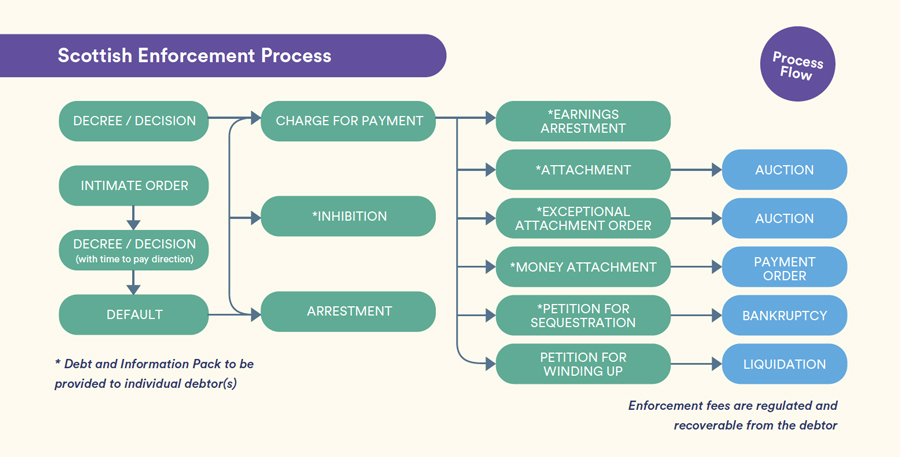Enquire Now
For All Client Enquiries please call 0141 565 5767 or click below to instruct us using our online form.
Utilising modern technology, we provide expedient citation, intimation and enforcement services to clients nationwide.
Sheriff officers are authorised to serve legal documents where a warrant for service has been granted by a court, at a known place of residence or place of business of the recipient. Examples include:
- Simple Procedure Claim Form (Form 3A) and Timetable (Form 3D)
- Ordinary Cause Initial Writ and Warrant (Form 01/02)
- Family Action Initial Writ (Form F14)
- Summary Cause Summons (Form 1)
- Court of Session actions
- Witness Citations
- Petitions for Sequestration / Liquidation
Sheriff officers can formally serve statutory documents required under a legal process, for example:
- Notice to Quit / Leave
- Notice of Proceedings
- Irritancy Notices
- Statutory Demands
- Short Form Demands
Once an order has been granted by a court or tribunal, Sheriff Officers and Messengers-at-Arms are authorised to enforce the warrant to achieve compliance.

Enforcement Methods
Normally the first step in the enforcement process, a Charge for Payment is the formal command to make payment within 14 days, served at a respondent’s place of residence or place of business. It allows an opportunity for a Sheriff Officer or Messenger-at-Arms to engage with the respondent and establish information which may enhance the recovery process. A charge for payment is a pre-requisite prior to an earnings arrestment, any attachment process, or petitioning for sequestration or liquidation and is valid for 2 years.
Served on a respondent’s employer and requires the employer to deduct a proportion of the respondent’s salary on each payday and remit the funds to the creditor. The earnings arrestment will remain in effect until the debt is repaid or the respondent leaves employment.
Please see attached link to prescribed Table of Deductions: https://www.legislation.gov.uk/ukpga/1987/18/schedule/2
Served in the hands of an arrestee (normally a banking group) requiring them to freeze any assets or funds held by them of behalf of the respondent. Arrested funds will be released by the arrestee to the creditor after 14 weeks (unless objections are lodged) or the respondent signs a mandate authorising early release. If an arrestment is successful in capturing funds, the arrestee is required to advise the creditor of the value of funds arrested within 21 days of service.
Served at a respondent’s place of residence or place of business and thereafter registered in the Register of Inhibitions, an inhibition prevents the respondent from selling or mortgaging any heritable property while the debt is outstanding. An inhibition is effective for 5 years from the date of registration and can be renewed if the debt is still outstanding.
Moveable property owned by the respondent (held out-with a dwelling) can be valued and secured against the outstanding debt. If payment is not received, attached articles can be auctioned and net proceeds from the sale paid towards the debt. An attachment is valid for six months and the respondent is not permitted to dispose of the attached articles whilst the attachment is in effect.
Authority to execute an attachment within a dwelling is not contained within a standard court order, however, following a further application to court, an order can be granted to attach, remove and auction non-essential items contained within a respondent’s dwelling.
Attachment and removal of cash or cheques within a commercial premises only. A payment order is thereafter obtained to authorise distribution of the monies.
A petition for sequestration is a separate court action, seeking to have the respondent declared insolvent, resulting in their estate being transferred to a trustee (insolvency practitioner) who will administer it for the benefit of all creditors. The services of a solicitor will be required to raise and oversee the sequestration action. Currently the minimum debt threshold is £5,000 for creditor petitions. If the respondent is a limited company, a petition for liquidation is the equivalent action.
Charge for Removing – served at the respondent’s place of residence or place of business and an “Occupier Copy” served at the subject address, requiring the respondent to vacate the subject address within 14 days.
Notice of Date of Removal – served at the subject address confirming the date and time arranged for the eviction. Minimum period of notice of 48 hours although normally served at the same time as the Charge for Removing.
Eviction – a sheriff officer will attend the subject address at the arranged date and time and is authorised to enter the property (including forcing entry, if necessary). Occupants will be removed from the property and an inventory taken of any items remaining. Once the order has been enforced and the property secured by a locksmith, the sheriff officer will append a ‘Certificate of Removal’ to the main door.